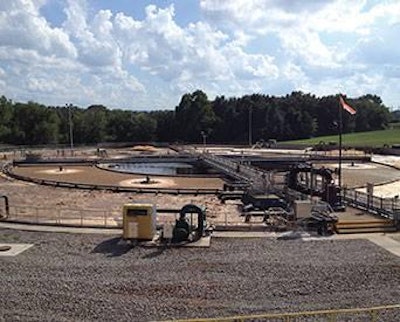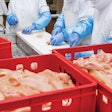
Tyson Foods River Valley Animal Foods (RVAF), Scranton, Arkansas, achieves low effluent concentrations of nitrogen and phosphorus with almost no chemical addition through the use of the Bardenpho process for treating poultry wastewater.
The wastewater treatment operation received honorable mention in the 2014 U.S Poultry and Egg Clean Water Award full-treatment category.
Wastewater generated from by-product recovery
The Scranton facility is designed to treat up to 1 million gallons a day of facility process and wastewater generated from by-product recovery. Wastewater system upgrades installed over the past few years have achieved a unique system capable of discharging water to the Arkansas River. As a result, the facility has easily met the award criteria of a minimum of two years of no significant non-compliances, notices of violations or any other type of enforcement action.
The RVAF facility operated an oxidation ditch, a technology often employed to remove carbonaceous biochemical oxygen demand (CBOD) and also ammonia through a process known as nitrification. The layout resembles a racetrack in that wastewater moves around a ring-, oval- or horseshoe-shaped basin. While an efficient system when operated properly, the nitrification process converts ammonia to nitrate by using CBOD, thus effectively tackling both pollutants. However, if nitrate or phosphorus removal is required, upgrades are needed.
Upgrade to four-stage Bardenpho system
To meet the challenge, the facility’s environmental team and management chose a design that modified the existing oxidation ditch without adding any new tanks to the system. The result was an upgrade to a four-stage Bardenpho system for combined biological phosphorus and nitrogen removal without many of the capital expenditures typically required.
Environmental, Heath and Safety Manager Dana Pierce said, “The aeration system was compacted into about half of the existing oxidation ditch outer ring, leaving the inner ring available for the needed anoxic zone, where it is important to provide mixing but without aeration. The retrofit converted ammonia in the aerobic zones and removed the resulting nitrate (denitrification) in the anoxic zone. The other half of the outer ring serves as a final polishing system that contains both aerobic and anoxic zones."
The upgrade achieved phosphorus and nitrogen removal without chemical costs but it required more CBOD, one of the pollutants the facility was tasked with eliminating. Fortunately, the environmental team knows its overall process well enough that they rerouted the dissolved air flotation effluent directly into the modified system from the anaerobic lagoon that precedes it. The required CBOD was obtained with a significant savings to the company.
Man-made wetlands capture stormwater sediments
In addition to its improved performance the facility has also worked closely with a local university to plant a variety of emergent and submerged native plants in a man-made wetland adjacent to the Tyson RVAF facility.
During an on-site tour, Pierce said, “Its purpose is to allow for the initial slowing of stormwater to capture sediments while still resembling a native wetland. We plan additional cells, the construction of hiking trails, and working with the local school district to build and place bird and wood duck houses.”
Pierce noted that the effort, like the RVAF daily reuse of approximately 200,000 gallons of treated wastewater for washing paved areas, were part of the facility and Tyson Foods’ overall commitment to environmental stewardship.
The Clean Water Awards recognize outstanding wastewater treatment facilities operated by poultry companies and allied industries. The full-treatment category covers facilities that fully reclaim wastewater prior to discharge into a receiving stream or final land application system.















